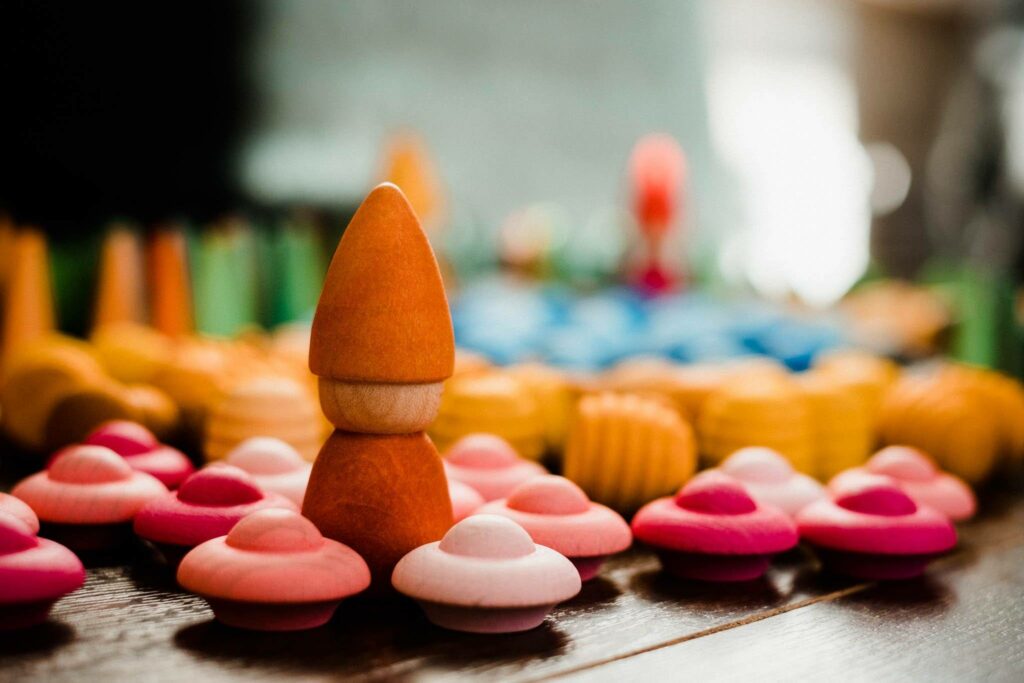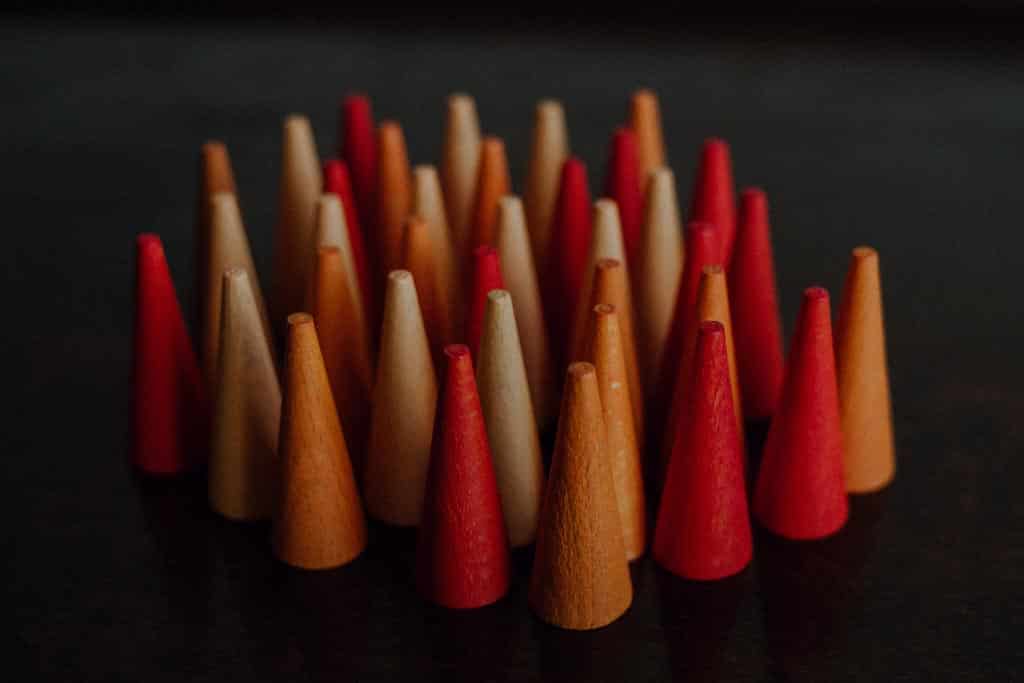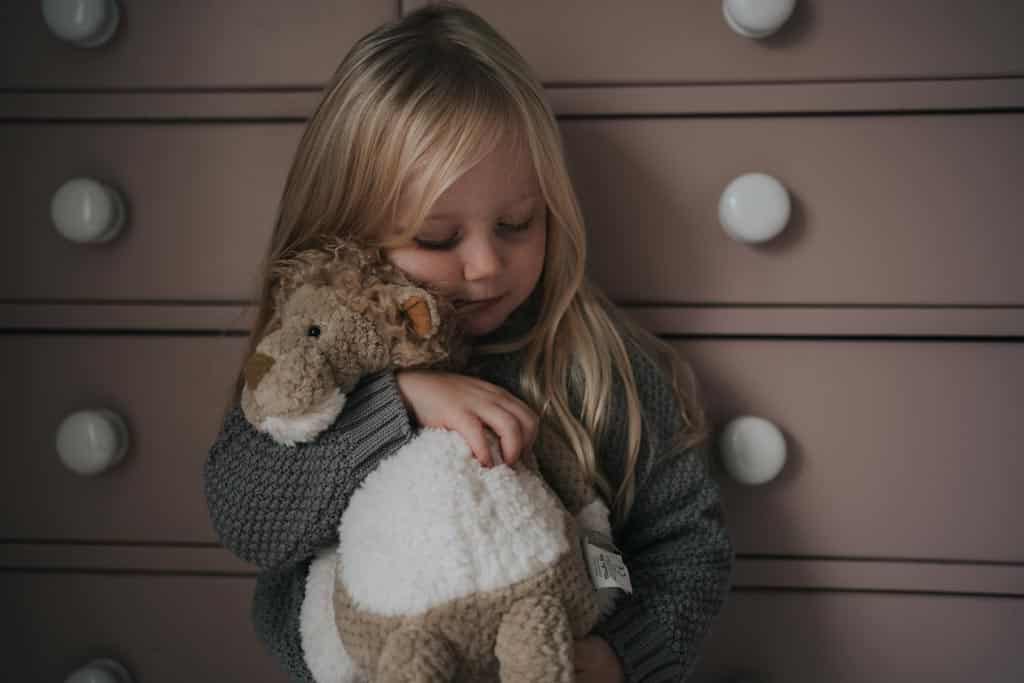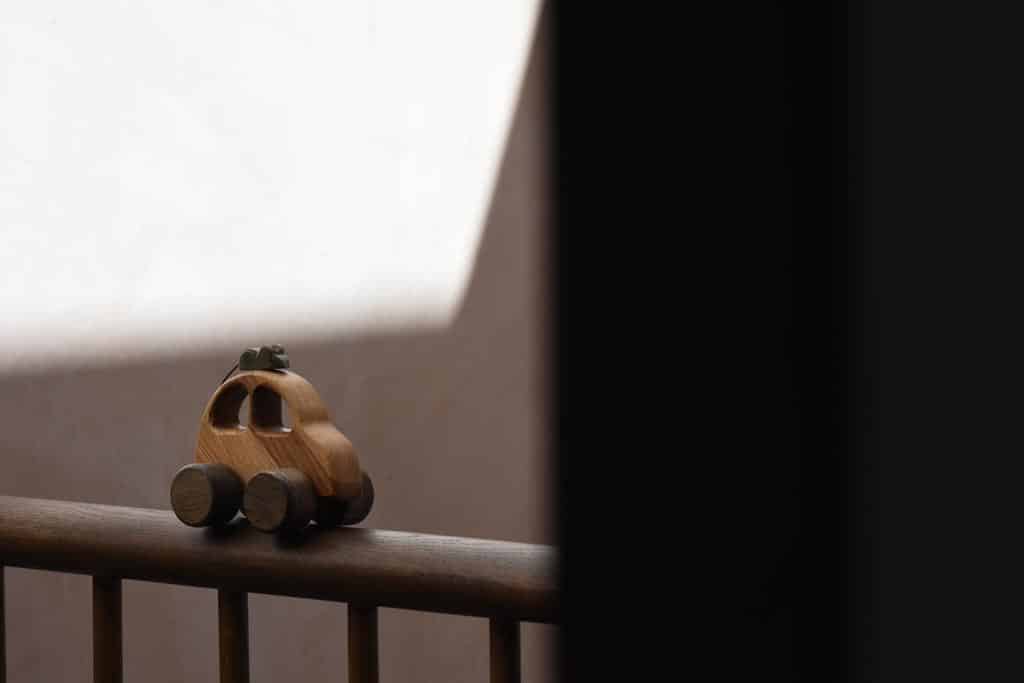How do you play with Grapat?
The simple shapes and lack of obvious purpose make them a mystery to most adults. But your child will know exactly what to do: explore.
With Grapat, the focus is on discovery and experimentation. The materials invite open-ended play, that is play without a fixed outcome.
What is Grapat?
Family-run Grapat is founded on the concept of natural simplicity. At their home in the Pyrenean mountains of Catalunya, Casiana and Jordi were inspired by watching their daughter play freely, with very few toys at her disposal. Unhindered by pre-determined ideas or games, she created worlds of her own from things she found at home or outside in nature, playing intensely for many happy hours.

They realised that when children are given freedom to imagine, their play becomes something they take very seriously indeed, working hard at it for hours and days, immersed in universes of their own creation. Inspired by this experience with their daughter, they set out to create their vision, a world of play that could flourish for other children in the way their daughter’s had.
Using only natural wood, their creations are less toys than props for children to use how they want to: simple peg dolls (‘nins’), cups, bowls, balls and blocks are at the core of the range, all of them in earthy, natural shades with the wood’s grain left visible. The natural qualities of the wood, the sound and the smell as well as the look and feel, are an important part of the Grapat experience.

How do you play with Grapat loose parts?
Loose parts are any material that is movable. In the context of play, this usually means small and numerous. Think buttons or pebbles or pine cones. The appeal lies in the ability to arrange them into patterns.
Grapat’s mandalas were designed with this kind of play in mind. The pieces come in a variety of shapes and colours and are the perfect size to hold between forefinger and thumb. Confident fine-motor-control is a happy by-product but the the art and science of placement is what makes them such a brilliant material to think with.
Sit with them a while and you’ll understand what makes them so fascinating. Even as adults we gain pleasure from these materials. There’s something soothing and almost meditative about arranging the pieces in a visually harmonious way. Some arrangements simply feel right.
Can you imagine your child arranging them along the arm of a chair or in a circle around their dining plate? If you’ve got an under five it’s unlikely they’ll choose to make one of the more complicated mandala patterns you often see on Instagram, but, even so, their instinct will be to bring order to the pieces.
Loose parts are a gateway to creativity and problem-solving for children and, like blocks, are a staple of the open-ended toy box. There’s no set way to play with them, and that’s the point. Simply grab a handful, place your first piece and see where it leads.
To learn more, read our guide to loose parts play.
Loose parts and schemas
Here at 100 Toys we especially interested in schema play. Notice how your child arranges the parts, perhaps in a line, a spiral or a circle. If this is a pattern that’s repeated over a number of days or weeks, you may have discovered their dominant (for now) schema. You can learn more about the hidden forces that drive toddler’s play in our guide to schemas.

Pattern-making
Pattern-making is an early form of maths. Red-white-orange-red-white-orange. It’s no different to 1-2-3-1-2-3, or even the notes of an arpeggio. What starts out as the seemingly random placement of loose parts by a toddler over time becomes something much more controlled in the hands of a preschooler. The human brain is wired to crave order and to see patterns.
Look at the unicorn above. There’s the suggestion of a pattern but it’s not quite there yet. Sometimes the pattern goes red-white-orange and sometimes it’s red-orange-white. Doesn’t it make you want to get in there and fix it? That’s mathematical thinking, something loose parts are brilliant for.

That’s better. There’s a proper pattern here and everything feels more harmonious. But, hang on, the alignment of the fans isn’t quite right. Don’t you find that disturbing? No? Maybe it’s just me! And I’ve just spotted that the top-left fan has a cone in the wrong place. Oh dear, back to the drawing board…
Nevertheless, we’ve learnt a version of the three times table and it’s all through play. When children get to school and they have to count in threes on a number line they’ll already have an intuitive grasp of how it works. And all because as a preschooler they had the time and space to freely explore pattern-making materials.

Mandalas – a special kind of loose parts play
A mandala can be many things but, typically, it’s a geometric pattern in a circular arrangement. A preschooler will eventually create sophisticated designs like the one above but there’s a huge amount to be learnt from a simple flower (below). The central piece with petals radiating outwards lays the foundations for later progress.


Make transient art
Transient art is temporary. A chalk drawing on the pavement may last until it rains; a scratched picture in the sand is swept away by the incoming tide.
You can also make pictures with sticks and stones and other found materials. It’s quick, easy and fun. But sometimes it’s nice just to reach for items you have to hand. At home that could mean buttons, straws or boxes of loose parts. What you use is up to you. Just make sure you have enough pieces to follow your imagination wherever it leads.
How simple to create such a beautiful picture!

Small world play with Grapat loose parts
Grapat’s loose parts range from abstract to figurative but they never look out of place in small world play. The green cones sit happily alongside the Ostheimer spruce as children are happy to suspend their disbelief completely.
This is a form of symbolic play. This cone is an abstracted tree, this red droplet is a fire. But the droplet could also be an autumnal bush, a rock or even an giant marshmallow in the Land of Sweets.
This is Grapat’s secret sauce, and the reason children return to the materials day after day, year after year. Babies enjoy exploring the pieces’ physical characteristics but as they grow they see the imaginative possibilities. A wooden coin which was once simply something to grasp or chew is, in the hands of a preschooler a macaroon, a king’s diamond or an emergency escape button.



What are Grapat Nins?
Nins simply means ‘children’ in Catalan. Grapat nins are similar to Grimm’s rainbow friends but come in a wider range of colours and sometimes sport hats, like the Tomten nins below.


What does Grapat mean?
Grapat means ‘handful’ in Catalan, and is suggestive of play with large quantities of undifferentiated objects.

#noplanetb
Grapat has long taken their environmental responsibilities seriously, using woods and inks that are grown and sourced ethically. But they have now gone a step further by becoming part of the No Planet B movement, striving to make the small changes that will have a big impact on climate change. You’ll see the #noplanetB hashtag on their packaging and across social media. Well worth looking into if, like us, you’re concerned by the amount of waste families with young children can generate.

Toy recommendations
Here are some suggestions broken down by age but – apart from choking hazards like the loose parts – most of the toys will be enjoyed by all children from birth to five.
Even if you have a lot of experience working with the under 5s, it’s not always easy to predict how they’ll play and what materials will appeal. In the 100 Toys house we keep the pieces accessible, in baskets on shelves at child height, and leave the children to choose.
The main thing to remember is to leave the play to your child. There is no set purpose. The materials are to be explored. Hold them, smell them, bite them. Post things into them and post them into things. Their simple design invites exploration.
For babies
What are the best Grapat toys for babies to play with? As always, we recommend a less-is-more approach to baby toys and games. They need very little, and an interested adult is by far the most important toy you can give them. But as they grow and start to explore the world around them, the best toys pose interesting questions.
A treasure basket is one of the best play activities for a baby. A collection of interesting items in a basket or bowl for your baby to discover and investigate, will keep them very busy indeed. Grapat’s Treasure Basket isn’t a proper treasure basket, as such, but it does include a variety of shapes that you can augment with other finds from around the home to make a unique basket of your own.
- Rings and coins are the perfect toy for a baby learning to reach for and grasp.
- Nested bowls are a good introduction to the concepts of ‘in’ and ‘out’.
- Bowns and balls for placing and colour matching.
- Hoops demand to be grabbed and pulled.
- Treasure basket
How do you play with nins, rings and coins?
The colours are beautiful and the pieces so tactile, but what do you actually DO with them?
The answer is: leave it to your child. There is no set purpose. The materials are to be explored. Hold them, smell them, bite them. Post things into them and post them into things. Their simple design invites exploration.

At first glance, Grapat’s rings, coins and cones may seem limited to sorting and pattern-making. But play with them for a while and it soon becomes clear that their simple shapes and colours offer countless creative possibilities. They’re also perfect for babies. They’re tactile, easy to grip and a natural choice for a first treasure basket.



For toddlers
- Lola. In, out, through; roll, stack and topple. You can play with Lola in so many ways.
- Cups with lids to collect, store, hide and even stack.
- You’ve got one minute. How many games can you make up to play with a set of wooden balls?
- Carla nins are a Grapat classic. The combination of plentiful nins, rings and coins makes for hours of heuristic play
- Houses and nins the toy for the toddler who is moving away from investigating objects and towards thinking about people, relationships and her place in the world.
For preschoolers
Grapat’s simple wooden free-play box is the perfect toy for an increasingly independent preschooler. It provides a self-contained space for their game or activity and has a profound effect on play. It encourages greater focus and allows them to return again to an activity that might otherwise be cleared away, giving them both a sense of ownership and the time to build over extended periods. In the 100 Toys house, we also use it for making Lego models. It keeps all the pieces in one place and can be whisked away at the first sign of a rampaging toddler.
It’s especially good for pattern making and arranging shapes (see loose parts, above) and for surveying finds from nature. It can also be used for sensory play when filled with tactile materials like rice or cornflakes. Young writers will enjoy drawing their finger through sand to make marks and practise letter formation.
- Loose parts
- Free play box
- Rainbow dishes for sorting and imaginative play
- Tinker tray
- Nins in the woods make for a simple yet open-ended small world set.
- Bowls and acorns look like a simple sorting game, too easy for a preschooler, but look again. The pincer and tripod grips required to squeeze the tongs make this set an excellent tool developing finger strength and co-ordination
- Follow the seasons with Grapat’s Perpetual Calendar.

Tinker trays
If your loose parts toy collection needs some organising then look no further than tinker trays. Rather like old printers’ drawers, they are the ideal shape and size for storing and displaying all your Grapat treasures. They are also a useful starting point for many sorting activities. Group by colour, form or any other characteristic you can think of.
Sorting activities
Sorting is one of the most important activities your child will ever do. It’s a foundational skill and, done right, encourages higher order thinking skills and focus. Read more in our guide to sorting activities.

Grapat and blocks – a perfect match
Small world play needs structure, big pieces to frame the play. Nins and loose parts can tell many stories but there isn’t enough material to construct a large scene. For that you need blocks. A single set is enough, and you might prefer blocks with a natural finish
Final word
The simple, pared-back look and feel of Grapat toys can seem unfamiliar and it can be tempting to opt for more ‘interesting’ alternatives. But have confidence in your child’s ability to imagine, sort, arrange and re-purpose these timeless pieces, and you’ll find them playing independently for many happy hours and years.







